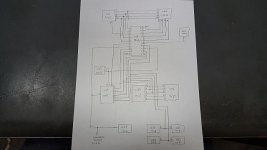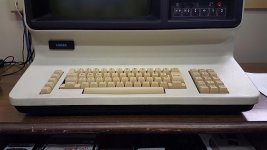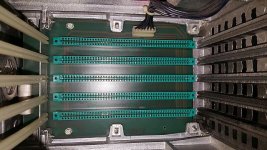Adding to your diagram... the backplane connector names from the solder-side photo.
Code:
+-----------+-----------+-----------+-----------+-----------+
| Option | Video | I/O | CPU | Comm. |
| J1 | J2 | J3 | J4 | J5 |
|Notch: @30+|Notch: @36+|Notch: None|Notch: @40+|Notch: @30+|
+-----------+-----------+-----------+-----------+-----------+
| | | | | |
| 2 1 | 2 1 | 2 1 | 2 1 | 2 1 |
| | | | | |
| s c | s c | s c | s c | s c | (solder/component)
| | | | | |
| 100 99 | 100 99 | 100 99 | 100 99 | 100 99 |
+-----------+-----------+-----------+-----------+-----------+
Tonight I'll add the connector pinout to the pin-list and maybe add a quick set for the discrete components. I might add the resistor pack pinouts too.
I'll email you attachments Friday or Saturday with:
1) Image: CPU Card Component-side Reference Designators with Corner Pin Numbers.
2) Image: CPU Card Solder-side Reference Designators with Corner Pin Numbers.
3) Text File: CPU Card Pin-List (for reference or quick lookup).
4) PDF File: CPU Card Pin-List color print of item 3.
Recommendation: Because ohming out the net connections of a printed circuit board is an exhaustive task, I'd recommend saving your time and patience until after the image net-list is taken as far as it can go. Because of hidden traces and hidden vias under chips, you'll have a lot to do in Phase 2. Best not to burn out early.
Usually I don't do a schematic palette of the chips until the net-list is complete, as its the first step of capturing the schematic from the list. But I think that a PDF of that schematic with parts only could be a useful document as you work with the CPU card diagnosing any problems with its bootup. I'll do that this weekend as it should be easy because I've already documented all the chip pinouts, names, and type in the spreadsheet lookup table.
By the way, the lookup table in the spreadsheet looks like:
Code:
Type Desc Pin-01 Pin-02 Pin-03 Pin-04 Pin-05
74'02a NOR 1Y 1A 1B 2Y 2A
74'02b 14 Pin o ' ' o '
74'04a INV 1A 1Y 2A 2Y 3A
74'04b 14 Pin o ' o '
74'08a AND 1A 1B 1Y 2A 2B
74'08b 14 Pin ' ' o ' '
74'124a VCO 2FC 1FC 1RNG 1CX1 1CX2
74'124b 16 Pin ' ' ' ' '
There are two lines for every chip; makes it easier to align the pin type with the pin name. The table width allows for 40pins and 100 unique components for now. It just has the chips from the CPU card and a few I copied into it from the Exidy Sorcerer project.
The CPU card chips sorted by pin count ("(S)" for socketed) then chip type (the Lookup Names):
Code:
U07 14p 74'02 Quadruple 2-input positive NOR gates.
U05 14p 74'04 Hex inverters.
U27 14p 74'04 Hex inverters.
U34 14p 74'04 Hex inverters.
U13 14p 74'08 Quadruple 2-input positive AND gates.
U19 14p 74'125 Quadruple bus buffers with 3-state outputs.
U22 14p 74'20 Dual 4-input positive NAND gates.
U02 14p 74'32 Quadruple 2-input positive OR gates.
U06 14p 74'32 Quadruple 2-input positive OR gates.
U48 14p 74'32 Quadruple 2-input positive OR gates.
U60 14p 74'32 Quadruple 2-input positive OR gates.
U14 14p 74'38 Quadruple 2-input positive NAND buffers with Open-Collector outputs.
U03 14p 74'74 Dual D-type positive-edge triggered flip-flops with preset and clear.
U04 14p 74'74 Dual D-type positive-edge triggered flip-flops with preset and clear.
U15 14p 74'74 Dual D-type positive-edge triggered flip-flops with preset and clear.
U11 14p DIP14 ResPak 220/330 ohms termination
U29 14p DIP14 NOT POPULATED
U62 16p 74'124 Dual voltage controlled oscillators.
U16 16p 74'366 Hex inverter bus drivers with 3-state output.
U23 16p 74'42 4-line BCD to 10-line decimal decoders.
U24 16p 74'42 4-line BCD to 10-line decimal decoders.
U01 16p DIP16 NOT POPULATED
U08 16p DIP16 NOT POPULATED
U09 16p DIP16 NOT POPULATED
U10 16p DIP16 ResPak 2.2K ohms
U12 16p DIP16 ResPak 2.2K ohms
U30 16p DIP16 Switch 8 Bit Toggle Switch
U31 16p DIP16 ResPak 2.2K ohms
U37 16p DIP16 Switch 8 Bit Toggle Switch
U35 16p(S) P8216 4-Bit parallel bidirectional bus driver.
U41 16p(S) P8216 4-Bit parallel bidirectional bus driver.
U46 16p(S) P8216 4-Bit parallel bidirectional bus driver.
U47 16p(S) P8216 4-Bit parallel bidirectional bus driver.
U54 16p(S) P8224 Clock generator and driver.
U17 16p(S) PD416 Dram 16Kx1-bit.
U18 16p(S) PD416 Dram 16Kx1-bit.
U25 16p(S) PD416 Dram 16Kx1-bit.
U26 16p(S) PD416 Dram 16Kx1-bit.
U32 16p(S) PD416 Dram 16Kx1-bit.
U33 16p(S) PD416 Dram 16Kx1-bit.
U39 16p(S) PD416 Dram 16Kx1-bit.
U40 16p(S) PD416 Dram 16Kx1-bit.
U44 16p(S) PD416 Dram 16Kx1-bit.
U45 16p(S) PD416 Dram 16Kx1-bit.
U50 16p(S) PD416 Dram 16Kx1-bit.
U51 16p(S) PD416 Dram 16Kx1-bit.
U57 16p(S) PD416 Dram 16Kx1-bit.
U58 16p(S) PD416 Dram 16Kx1-bit.
U64 16p(S) PD416 Dram 16Kx1-bit.
U65 16p(S) PD416 Dram 16Kx1-bit.
U55 20p 74'273 Octal D-type flip-flop with clear.
U38 20p 74'374 Octal D-type transparent latches and edge-triggered flip-flops.
U43 20p 74'374 Octal D-type transparent latches and edge-triggered flip-flops.
U52 20p 74'374 Octal D-type transparent latches and edge-triggered flip-flops.
U36 20p 81'95 Octal buffers with tri-state outputs.
U49 20p 81'95 Octal buffers with tri-state outputs.
U59 20p 81'95 Octal buffers with tri-state outputs.
U61 20p 81'95 Octal buffers with tri-state outputs.
U56 20p(S) TBP1842 512 x 8 Prom.
U21 24p P8212 8-bit output port and input port.
U20 24p(S) P8214 Priority interrupt control unit.
U63 28p(S) D3242 Memory interface integrated circuit.
U42 28p(S) P8228 System Controller and Bus Driver
U28 40p P8257 Programmable DMA controller.
U53 40p(S) P8080 CPU microprocessor.
This ordering made quick work of the spreadsheet generated pin-list. I did all the 14 pin chips first, the 16 etc.
For each pin count type, I made/modified one chip pattern block that required only the chip type and the reference designator be entered. It used that to build the rest of the fields and to extract pin names and pin types and notes from the lookup table.
I'd block copy that pattern to the bottom of the pin-list for each reference designator. Repeated types were easier done at the same time because only the reference designator needed to be changed; hence this ordering.
When done I just sorted the first column of the pin-list to restore it to U01-U65 order and converted the entire pin-list block to values-only so it didn't have to recalculate or re-lookup anything.
This end result for chips only:
Code:
Empty 16 Pin
DIP U01
U01-01
U01-02
U01-03
U01-04
U01-05
U01-06
U01-07
U01-08
U01-09
U01-10
U01-11
U01-12
U01-13
U01-14
U01-15
U01-16
74'32 14 Pin
OR U02
1A U02-01
1B U02-02
1Y U02-03 o
2A U02-04
2B U02-05
2Y U02-06 o
GND U02-07 g
3Y U02-08 o
3A U02-09
3B U02-10
4Y U02-11 o
4A U02-12
4B U02-13
VCC U02-14 p
etc etc etc...
PD416 16 Pin
16KDram U65
VBB U65-01 p
DIN U65-02
WRITE# U65-03
RAS# U65-04
A0 U65-05
A2 U65-06
A1 U65-07
VDD U65-08 p
VCC U65-09 p
A5 U65-10
A4 U65-11
A3 U65-12
A6 U65-13
DOUT U65-14 o
CAS# U65-15
GND U65-16 g




